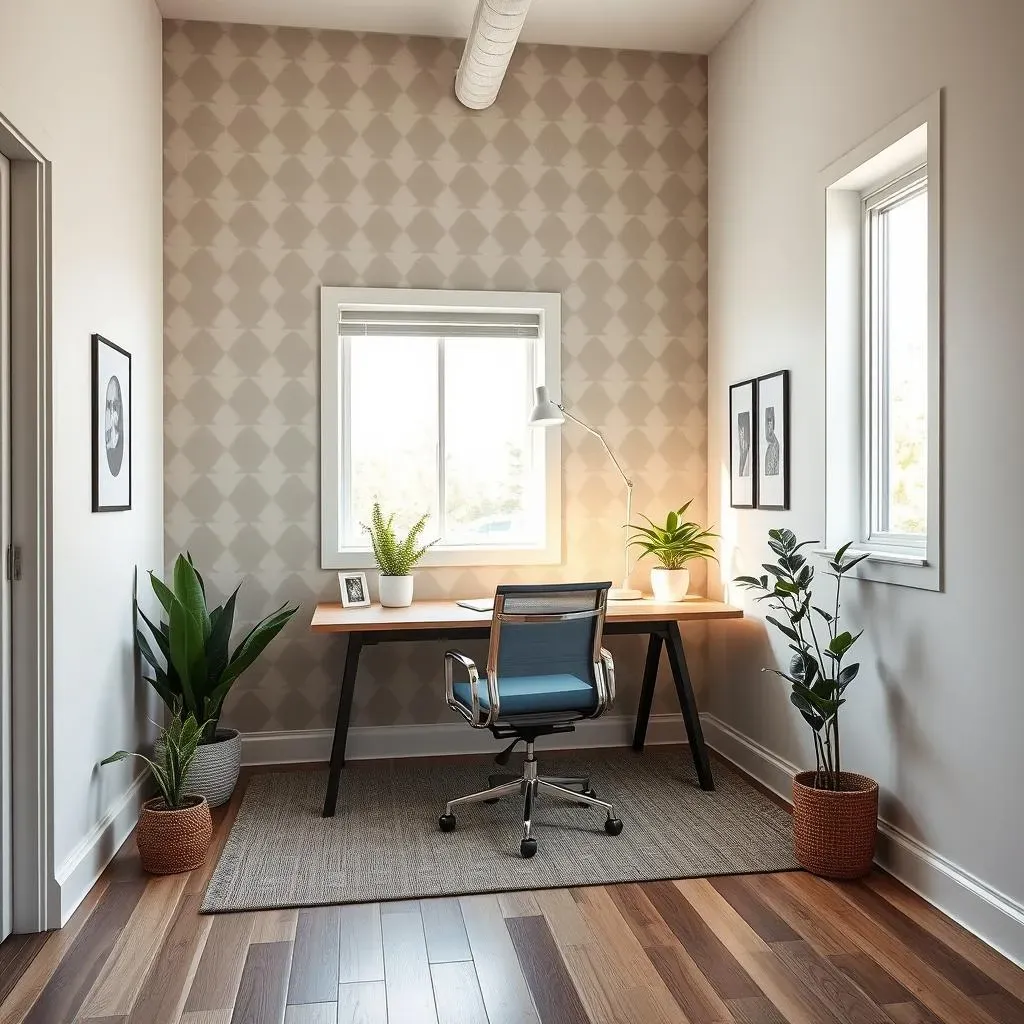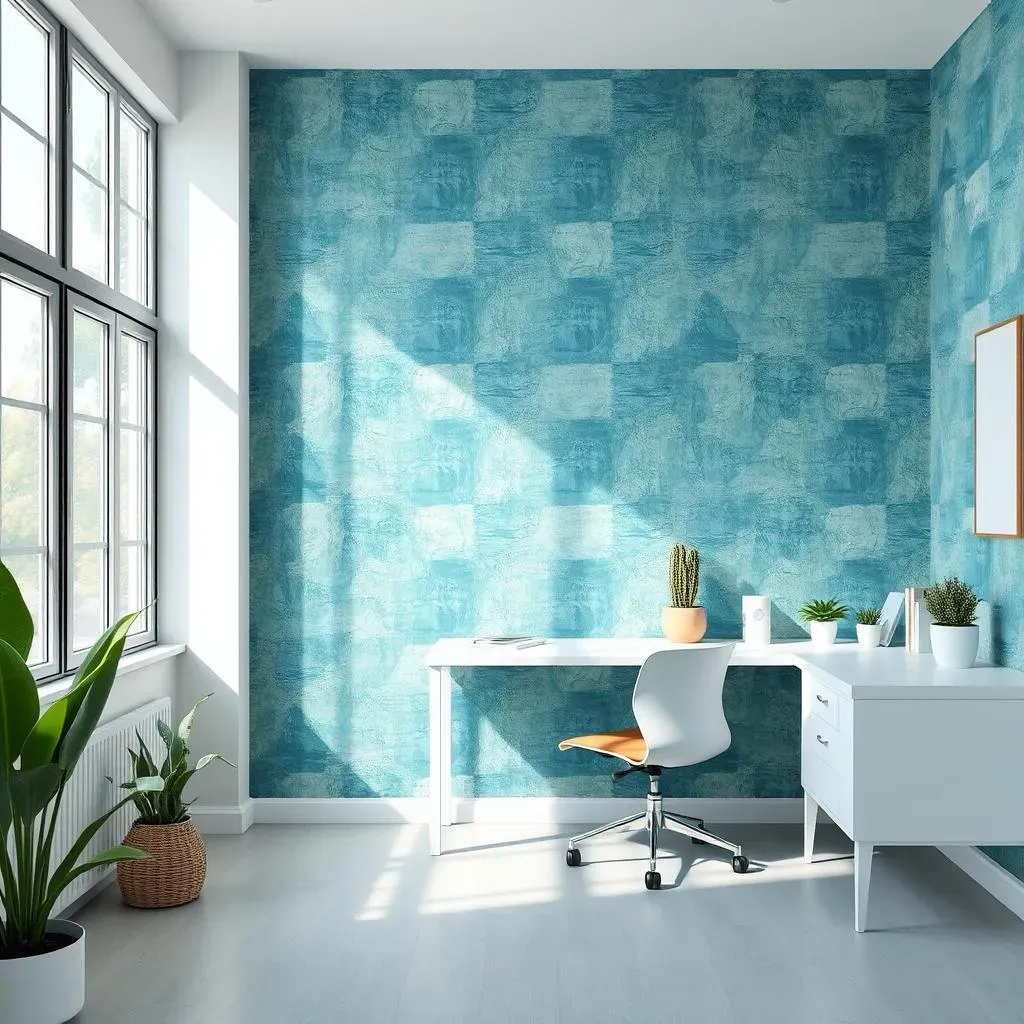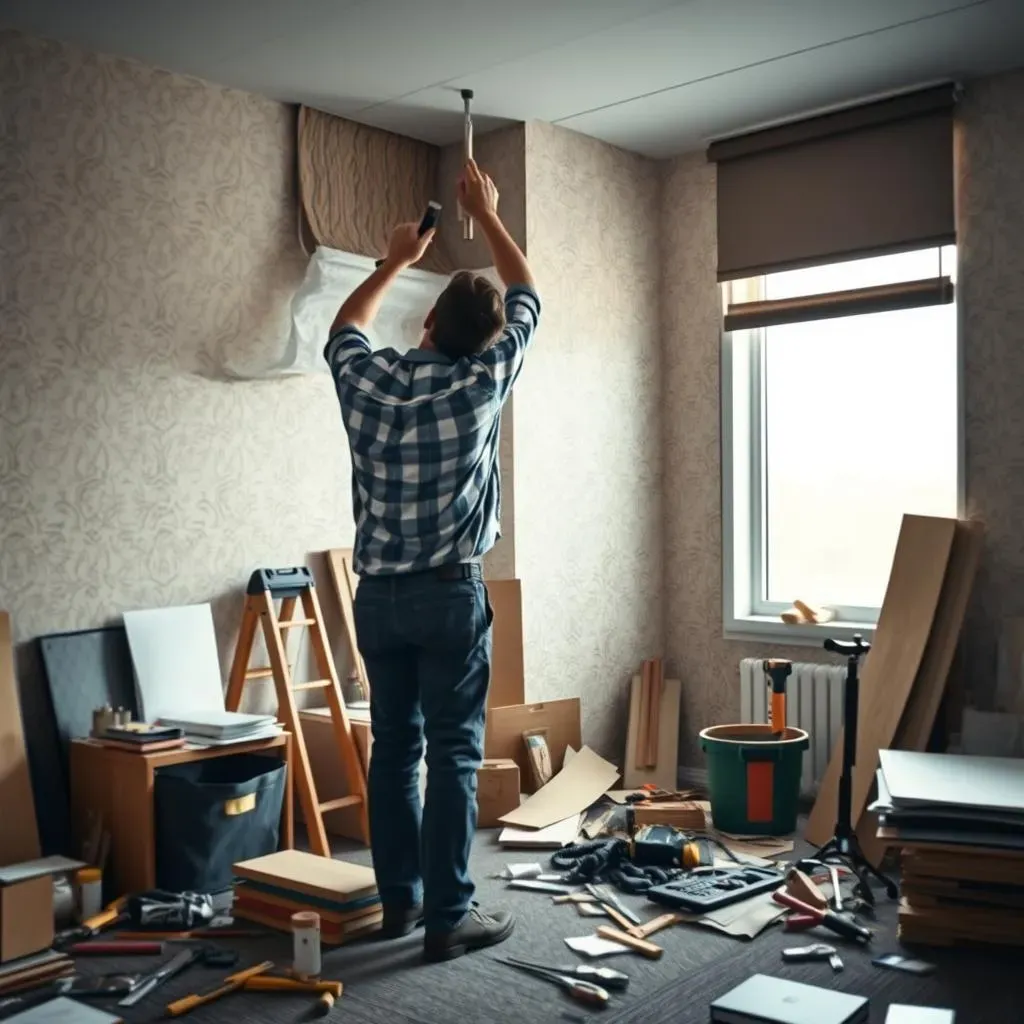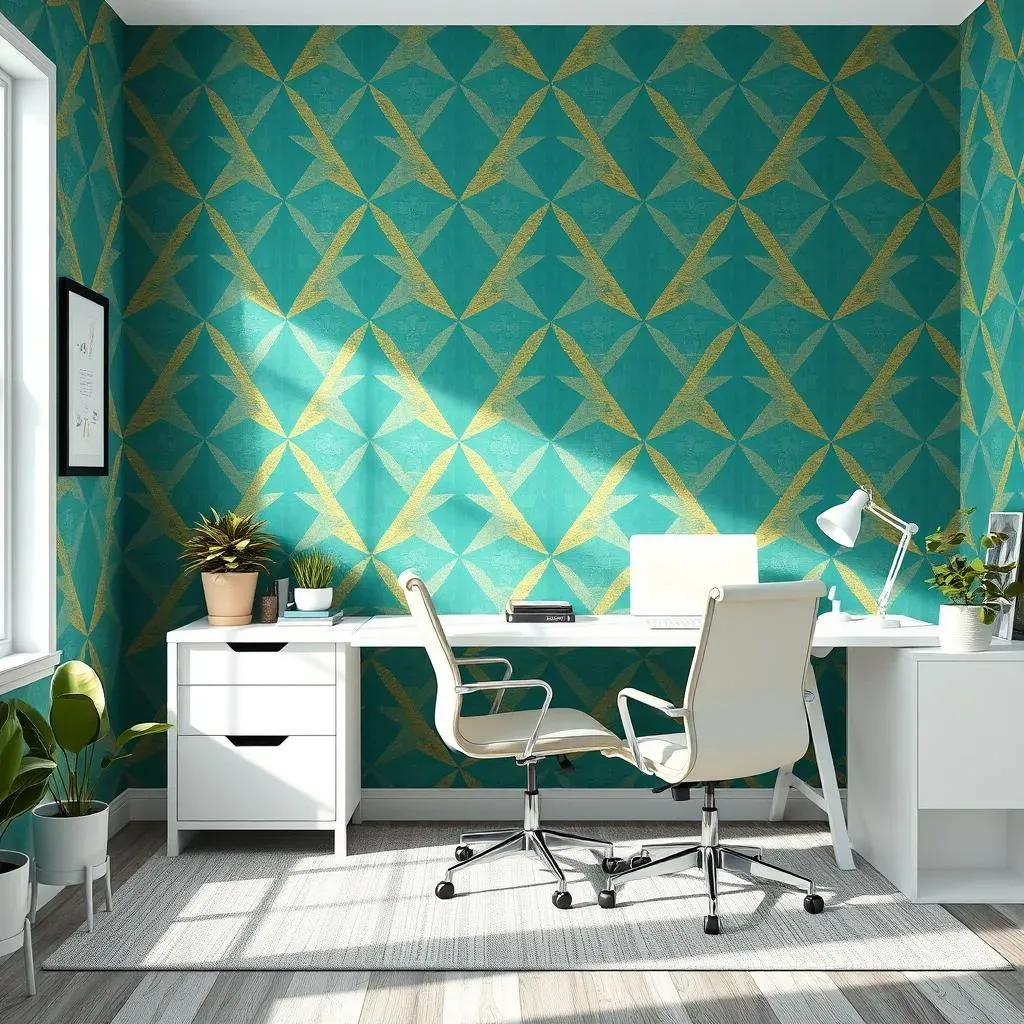Table of Contents
Ever feel like your office is a bit…blah? Like staring at a blank wall all day? I know I have. That's where the magic of an office wallpaper accent wall comes in. It’s like giving your workspace a personality transplant, and trust me, it’s easier than it sounds. Forget boring beige; we’re talking about injecting some serious style and maybe even a little motivation into your daily grind. This isn't just about slapping some paper on a wall; it's about creating a space that actually makes you feel good to be in. We’ll explore why these accent walls matter, how to pick the perfect wallpaper, and even some tricks to make the installation process less of a headache. So, if you’re ready to ditch the drab and embrace a workspace that reflects your awesome, keep reading. We're about to make your office walls sing, one strip of wallpaper at a time.
Why an Office Wallpaper Accent Wall Matters

Why an Office Wallpaper Accent Wall Matters
The Psychology of a Good Workspace
Let's be real, staring at a plain wall all day is a total snooze-fest. It's like your brain is begging for something, anything, to break the monotony. An office wallpaper accent wall isn't just about looking pretty; it's about how the space makes you feel. Think of it like this: a boring wall is like a flat soda – it just doesn't have any zing. But a well-chosen wallpaper? It's like a burst of flavor, waking up your senses and getting your creative juices flowing. It can boost your mood, making those tough tasks feel less like a chore and more like a challenge you're actually excited to tackle.
I've seen it happen firsthand. A friend of mine was working from home, totally uninspired, until she put up a bold geometric wallpaper in her office. Suddenly, she was buzzing with ideas. It wasn't just the new pattern, it was the energy the wall brought into the room. It was like the space was saying, "Hey, let's get stuff done, and let's have fun doing it!" That's the kind of power a good accent wall can have.
More Than Just Decoration
Beyond the mood boost, an office wallpaper accent wall can actually define your workspace. It's like drawing a line in the sand, saying, "This is where the magic happens." In open-plan homes or shared spaces, an accent wall can create a visual separation, making it easier to focus on work without feeling like you're constantly on display. It’s also a fantastic way to show off your personality. A bold floral print? You're probably a creative soul. A sleek, minimalist pattern? You might be all about efficiency. Your accent wall is like a visual resume for your work style.
Plus, let's not forget the practical side. A well-chosen wallpaper can hide imperfections on the wall, like small dings or uneven paint. It's a quick and relatively inexpensive way to give your workspace a refresh without needing a full-blown renovation. It's like a mini-makeover for your office, and who doesn't love that? I know I do. It's a win-win: a space that looks good and feels good, which means you're more likely to get things done.
Benefit | Description |
|---|---|
Mood Booster | Enhances energy and creativity. |
Workspace Definition | Creates a visual separation, aids focus. |
Personality Showcase | Reflects your style and work ethic. |
Practical Solution | Covers wall imperfections, affordable refresh. |
Choosing the Right Office Wallpaper for Your Accent Wall

Choosing the Right Office Wallpaper for Your Accent Wall
Pattern Play: Finding Your Vibe
Okay, so you’re ready to pick a wallpaper, but where do you even start? Well, think about what kind of energy you want in your office. Do you want to feel calm and collected, or energized and ready to take on the world? Patterns are key here. Big, bold geometrics can make a statement and add a modern feel, while subtle florals or nature-inspired prints can create a more relaxed vibe. I'm a sucker for a good geometric pattern myself; it makes me feel like I'm in a cool, futuristic command center, ready to conquer my to-do list. But if you prefer something more chill, maybe a soft, watercolor-style pattern is more your speed. It’s all about what speaks to you and your work style.
Don't be afraid to get a little wild. If you're feeling adventurous, try mixing and matching patterns, but make sure they complement each other. It's like choosing the right outfit – you want it to look put-together, not like you got dressed in the dark. And if you're not sure where to start, grab some samples. Most places will let you order a few small pieces to see how they look in your space. It’s way better than regretting a whole roll of wallpaper.
Color Considerations: More Than Just Looks
Color is just as important as pattern. It’s not just about picking your favorite color; it’s about picking a color that works for your space and your mental state. Bright colors can be great for boosting energy, but they might also be distracting if you’re trying to focus. On the flip side, dark colors can create a cozy, sophisticated atmosphere, but they might make a small office feel cramped. I tend to go for muted blues and greens; they’re calming but still have enough color to keep things interesting. It's like having a mini-vacation on your wall, which is always a plus during a stressful workday.
Think about the existing furniture and decor in your office. You want the wallpaper to complement what you already have, not clash with it. It’s like choosing the right accessory for an outfit – it should enhance the look, not fight it. And don’t forget about lighting. The same wallpaper can look totally different under natural light versus artificial light. So, before you commit, test out your samples in different lighting conditions. It’s all about making sure the color is just right for your space.
Consideration | What to Think About |
|---|---|
Pattern | Geometric, floral, nature-inspired; find your vibe. |
Color | Energy, focus, existing decor, lighting. |
Material | Durability, ease of installation, texture. |
Material Matters: Beyond the Pretty Paper
Okay, so you've nailed the pattern and color, but don't forget about the actual material of the wallpaper. It's not all created equal. Some are easier to install than others, and some are more durable. For example, peel-and-stick wallpaper is a total lifesaver if you're not a pro at wallpapering. It’s like adult stickers, and who doesn’t love stickers? But if you’re going for a more upscale look, you might want to consider a textured wallpaper. It's like adding a whole new dimension to your walls, and it can really elevate the look of your office. I remember when I first started, I didn't pay much attention to the material, and let me tell you, that was a mistake I won't make again.
Also, think about the long-term. If you have kids or pets, you might want to go for a more durable and washable option. It’s like choosing a car – you want something that looks good but also can handle a few bumps along the road. And don’t forget to consider the texture of the wallpaper. A smooth wallpaper will have a different feel than a textured one. It's like choosing between a soft blanket and a rough towel – both have their place, but it's all about what you prefer. Picking the right material can make all the difference in how your accent wall looks and how long it lasts.
DIY Tips and Tricks for Installing Your Office Wallpaper Accent Wall

DIY Tips and Tricks for Installing Your Office Wallpaper Accent Wall
Prep Like a Pro: Setting the Stage
Alright, so you've got your wallpaper, you're excited, but hold your horses! Before you even think about peeling off that backing, you need to prep your wall like a pro. I'm talking about cleaning, patching, and priming. It's like getting ready for a race – you wouldn't just show up in your pajamas, right? The same goes for wallpaper. First, wipe down your wall with a damp cloth to get rid of any dust or grime. Then, fill any holes or cracks with spackle and let it dry. If you have textured walls, you might want to consider using a wall liner to create a smooth surface. It's like giving your wallpaper a blank canvas to shine on. And finally, apply a primer to help the wallpaper stick and prevent any bleed-through from the wall. Trust me, this prep work is worth its weight in gold; it’ll make the installation process so much smoother and the end result so much better.
I remember one time, I skipped the priming step, thinking I could get away with it. Big mistake! The wallpaper didn’t stick properly, and it started peeling off within a week. Lesson learned: don't cut corners when it comes to prep work. It's like building a house – you need a solid foundation to make it last. And if you have any doubts, watch a few tutorials online. There are tons of great resources out there that can walk you through each step. I'm a big fan of watching YouTube videos; it's like having a personal instructor in your own home.
Tools of the Trade: What You'll Need
Okay, let's talk tools. You don't need to go out and buy a whole toolbox full of fancy gadgets, but there are a few essentials that will make your life a whole lot easier. First, you'll need a measuring tape and a level. You want your wallpaper to be straight and even, not like a drunken sailor on a stormy sea. Then, you’ll need a sharp utility knife or wallpaper cutter. Precision is key here; you don't want to end up with jagged edges. A smoothing tool or a plastic smoother is also a must-have. It’ll help you get rid of any air bubbles and wrinkles, making your wallpaper look seamless. And finally, grab a wallpaper sponge or a damp cloth for cleaning up any excess paste. It's like having a mini-cleaning crew on standby, ready to tackle any mess you might make.
I like to think of these tools as my trusty sidekicks. They're not the flashiest, but they get the job done, and they make the whole process so much less stressful. And don't forget a drop cloth or some old newspapers to protect your floors. It’s like putting on an apron before you start cooking; it’s all about preventing unnecessary messes. And if you're using paste, make sure you have a bucket or tray and a paste brush or roller. It’s like preparing your paint palette before you start painting, it's all about having everything you need within reach.
Tool | Purpose |
|---|---|
Measuring Tape & Level | Ensures straight and even wallpaper. |
Utility Knife/Wallpaper Cutter | Provides clean, precise cuts. |
Smoothing Tool | Removes air bubbles and wrinkles. |
Wallpaper Sponge/Damp Cloth | Cleans up excess paste. |
Installation Hacks: Making it Stick
Now, for the moment you've been waiting for – the actual installation. If you're using peel-and-stick wallpaper, start by peeling off a small portion of the backing and aligning the wallpaper at the top of your wall. Work your way down, smoothing out any air bubbles as you go. It’s like applying a giant sticker, but with a bit more care. If you’re using traditional wallpaper, apply the paste to the back of the wallpaper, fold it in on itself, and let it sit for a few minutes before applying it to the wall. This is called "booking," and it helps the paste activate. It's like letting your bread dough rise before baking it, it's all about patience.
When you’re lining up the next strip of wallpaper, make sure to match the pattern carefully. It’s like completing a puzzle, and you want all the pieces to fit perfectly. And if you have any air bubbles, use your smoothing tool to push them out. If you have any excess wallpaper at the top or bottom, trim it with your utility knife. It’s like giving your wallpaper a final haircut, making sure it looks neat and tidy. And finally, don’t be afraid to ask for help. Wallpapering can be a two-person job, especially if you're dealing with large pieces. It’s like having a partner in crime, making the whole process more fun and less stressful.
Troubleshooting Tips: Handling the Hiccups
Let’s be honest, things don’t always go perfectly, even with the best-laid plans. If you run into any issues, don’t panic! If you get air bubbles, try using your smoothing tool again. If that doesn't work, you can use a pin to poke a tiny hole in the bubble and then smooth it out. It’s like performing a mini-surgery on your wall. If the wallpaper doesn't line up perfectly, don't worry, you can usually adjust it slightly. And if you have any seams that are visible, you can use a seam roller to flatten them out. It’s like applying a magic wand to your wall, making any imperfections disappear.
If you accidentally tear the wallpaper, don’t fret. You can usually patch it with a small piece of leftover wallpaper. It's like mending a small hole in your favorite shirt, it's all about being resourceful. And if you have any stubborn areas that just won’t stick, you can use a bit of wallpaper paste to secure them. It’s like giving those areas an extra hug, making sure they stay in place. And if all else fails, don’t be afraid to call in a professional. Sometimes, it’s better to admit defeat and let someone else take over. It's like calling in a mechanic when your car breaks down – sometimes, it’s just the smartest thing to do.
- Air Bubbles: Smooth with a tool, or poke a tiny hole with a pin.
- Misaligned Patterns: Gently peel back and realign.
- Visible Seams: Use a seam roller to flatten.
- Tears: Patch with leftover wallpaper.
- Stubborn Areas: Use extra wallpaper paste.
